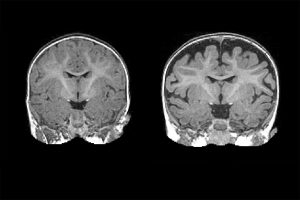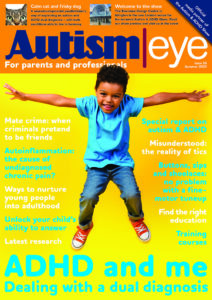Scientists are hailing a “major finding” in spotting signs of autism in the brain of babies.
They say it lays the groundwork for paediatricians to predict autism at a very young age. They also say it will help in the search for a potential treatment.

Right: MRI of a baby at six months who went on to be diagnosed with autism at two years. The dark space between the brain folds and skull indicate increased amounts of cerebrospinal fluid. Left: MRI of a baby who was not diagnosed with autism at age two. It shows a decreased amount of CSF. Photo by Carolina Institute for Developmental Disabilities
The scientists studied MRI brain scans. They found an anomaly in nearly 70 per cent of babies at high risk of developing autism who then went on to be diagnosed.
Fluid around the brain
The toddlers had a substantially greater amount of extra-axial cerebrospinal fluid (CSF) around the brain at the ages of six and 12 months. This was long before the diagnosis of autism is possible.
The more CSF the infants had at six months the more severe their autism symptoms were at two years of age.
The University of North Carolina School of Medicine conducted the research. Co-senior author of the study was Joseph Piven, MD. He is director of the Carolina Institute for Developmental Disabilities (CIDD) and holds the title of Thomas E Castelloe Distinguished Professor of Psychiatry.
Potential biomarker of autism
Piven said that the CSF fluid “is easy to see on standard MRIs and points to a potential biomarker of autism before symptoms appear years later”.
He added: “We also think this finding provides a potential therapeutic target for a subset of people with autism.”
The findings point to faulty CSF flow as one of the possible causes of autism for a large subset of people.
Brain health
“We know that CSF is very important for brain health, and our data suggest that in this large subset of kids, the fluid is not flowing properly,” said Mark Shen, PhD, postdoctoral fellow at CIDD and first author of the study.
“We don’t expect there’s a single mechanism that explains the cause of the condition for every child. But we think improper CSF flow could be one important mechanism.”
Until the last decade, the scientific and medical communities viewed CSF as merely a protective layer of fluid between the brain and skull. They thought it was not necessarily important for proper brain development and behavioural health.
Crucial filtration system
But scientists then discovered that CSF acted as a crucial filtration system for byproducts of brain metabolism.
Every day, brain cells communicate with each other. These communications cause brain cells to continuously secrete byproducts such as inflammatory proteins that must be filtered out several times a day. The CSF handles this. The body then replenishes it with fresh CSF four times a day in babies and adults.
In 2013, Shen co-led a study of CSF in infants at the University of California, Davis. Using MRIs, the team found substantially greater volumes of CSF in babies that went on to develop autism. But they cautioned that the study was small. It included 55 babies, 10 of whom developed autism later. The study therefore needed to be replicated in a larger study of infants.
High risk
In this most recent study of CSF, the researchers enrolled many more infants – 343 in total. Some 221 of them were at high risk of developing autism due to having an older sibling with the condition.
Forty-seven of the infants had a diagnosis of autism at 24 months. The team compared their infant brain MRIs to those of other infants without a diagnosis of autism at the same age.
David Amaral, PhD, is director of research at the UC Davis MIND Institute. He was also co-senior author of the current study. He said: “Normally, autism is diagnosed when the child is two or three years old and beginning to show behavioral symptoms; there are currently no early biological markers.
“That there’s an alteration in the distribution of cerebrospinal fluid that we can see on MRIs as early as six months, is a major finding.”
The study appeared in the journal Biological Psychiatry.
Published: 6 March 2017















